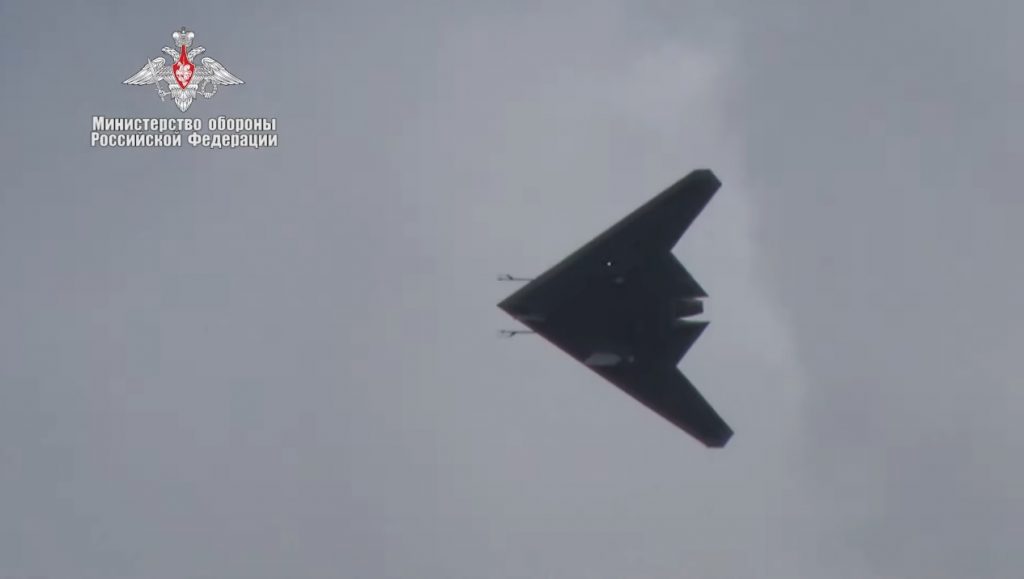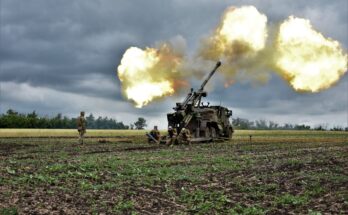
The Russian combat drone Okhotnik-B may finally be wrapping up testing, enabling it to enter serial production, according to Sergei Semka, vice-governor of the Novosibirsk Oblast where the drones will be assembled. Semka told media on January 25 that the drone will finish state trials soon, and should go into production at the Sukhoi subsidiary Novosibirsk Aircraft Production Association Plant (NAPO) sometime during the second half of 2024.
Russia has lagged behind its peers in the production of unmanned combat aerial vehicles (UCAVs), only starting to introduce domestically-designed versions into service in recent years. Procurement of Kronshtadt Group’s Orion drone, capable of delivering airstrikes, got underway in 2021. The Russian Ministry of Defense ordered a batch of Altius-RU UCAVs in February 2021.
The S-70 Okhotnik-B, however, has yet to enter serial production, missing several deadlines already. The UCAV was publicly revealed in 2019, when its first prototype made its maiden flight, and it entered weapons testing two years later. At least two prototypes were produced to undergo state testing, which is the final leg of trials before a system is approved for full production.
Ahead of production, Okhotnik made its combat debut in Ukraine in mid-2023, conducting strikes on several locations in Ukraine’s Poltava Oblast. It has not been referenced again in Ukraine – and nor were any of the prototypes seemingly lost in combat – which would suggest its deployment was brief and likely away from the site of major operations, where it could be vulnerable to Ukrainian air-defenses. Russia has tested some of its other new-generation equipment in a similar way, apparently sending T-14 Armata tanks to the front, but only in limited fashion and for only a short period of time before they were withdrawn.
Several weeks after the Okhotnik deployed to Ukraine, a source in the Russian Aerospace Forces command told state media TASS that state trials would conclude before the end of 2023, enabling production for the Army to begin early in 2024. Semka’s statement this week suggests that serial deliveries will begin likely no earlier than December 2024, perhaps stretching into 2025.
It’s not especially evident what would have caused the latest delay – Russian state media hardly being the most inquisitive – although for what it’s worth Semka himself had commented earlier in 2023 that he viewed serial production as still “a couple of years” away.
A bigger question will be the drone’s purpose once it does enter service. UCAVs drove significant global interest during the 2000s and 2010s, but have lately been upstaged by a new contender, prompting questions about where they fit into a modern battlefield. The U.S. heavily-employed combat drones in its counterinsurgency missions, spurring copy-cat creations in China that eventually found their way into regional militaries in the Middle East and elsewhere. Turkey’s Bayraktar TB2 UCAVs generated substantial attention after their usage in wars in Syria, Nagorno-Karabakh, and Libya.
The TB2s shined in the early days after Russia’s invasion of Ukraine, as well. The UCAVs took advantage of (and contributed to) chaos on the Russian side, disrupting advancing Russian forces and harassing logistics lines with airstrikes, footage of which went viral through social media. But most UCAVs aren’t especially ‘stealthy’, meaning that as Russia tidied-up its operations, its forces were better able to identify and destroy or neutralize the TB2s with air-defense and electronic warfare systems.
Instead of UCAVs, the primary strike drones on the battlefield in Ukraine of late have been loitering munition UAVs, which both combatants have heavily employed to perform one-way strike missions on fortified positions, troop formations, or infrastructure. They can also serve as worthy decoys, pairing well with cruise missiles to saturate the skies with viable targets for enemy air-defenses. And while just as vulnerable to air-defense systems as UCAVs, these types of drones are much cheaper to produce than a UCAV platform, meaning that they can be manufactured en masse and launched in swarms.
Russia lagged in production of loitering munition drones before the war, too, but adjusted quite quickly with the help of Iran, which supplied its Shahed-131 and -136 drones. Russia’s industry soon produced its own versions of those drones, while also introducing new types, such as ZALA’s Lancet or Kalashnikov’s Kub. By this point in the war, Moscow now enjoys a substantial advantage over Ukraine in terms of sheer numbers of loitering munition drones and productive capacity.
So with the growing emphasis on loitering munitions, where might the Okhotnik-B fit onto the evolving modern battlefield? At least on physical appearance, the drone is intended to be low-observable, incorporating ‘stealth’ technologies that on paper make it harder to detect. Moreover, as part of the drone’s flight testing program, the Russian Air Force paired it with combat aircraft like the Su-57, indicating a role helping the stealth fighter jet complete its missions. But testing the ‘robotic wingman’ concept has demonstrated challenges, as well.
For one, the Su-57 itself is only in low-rate production, with recent deliveries geared primarily towards pilot training. (It has seen combat duty in Syria and Ukraine, but, like the Okhotnik and T-14, only on a very limited basis.) In November 2023, Izvestia reported that the aviation conglomerate United Aircraft Corporation has patented a two-seat stealth variant of the Su-57, development of which is still in its infancy. Experts pointed out to the media outlet that it would be quite difficult for a single pilot in combat conditions to properly operate all of his onboard systems while also having to manage a robotic wingman. Other reports have highlighted that the need for a two-seat Su-57 plausibly indicates difficulties in developing competent artificial intelligence systems that could control the Okhotnik or other drones in lieu of a second pilot.
The Russian Army nevertheless has “several dozen” Okhotnik drones on order, TASS’ source said in August 2023. And if Semka’s statements are borne out, some of those could begin entering the military within the next 12 months.
Military markets analyst, covering Eurasia, Middle East, and Africa.




